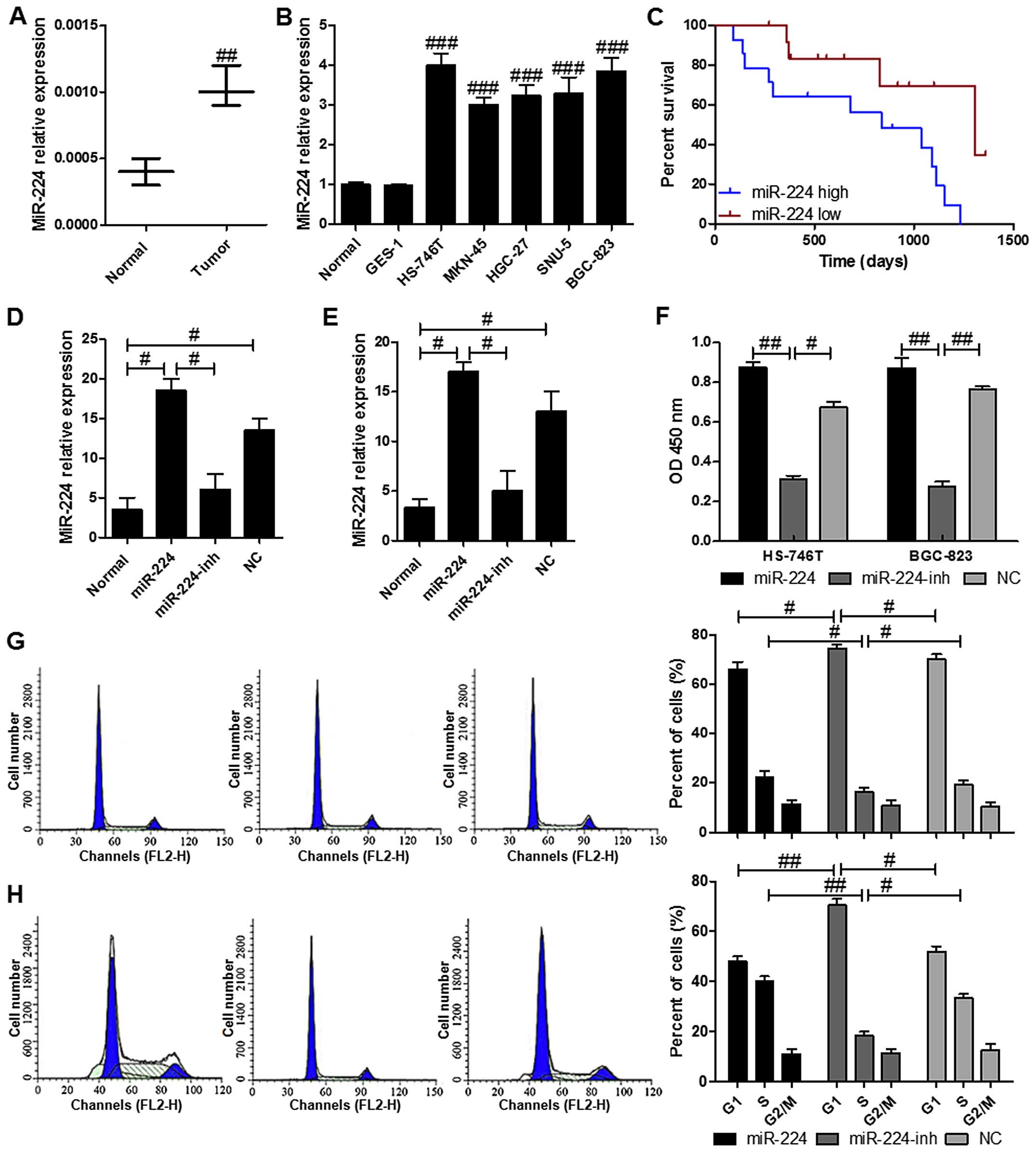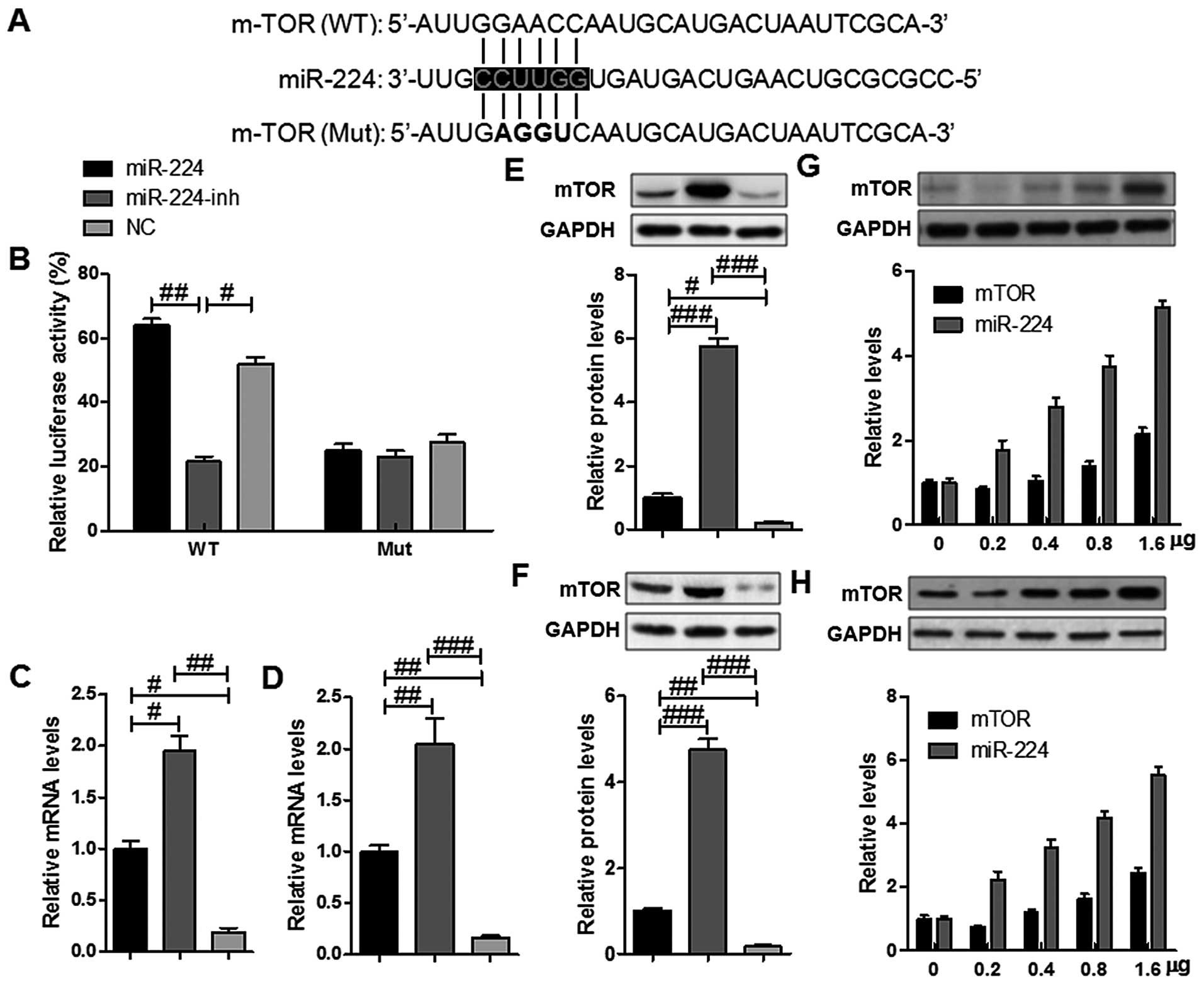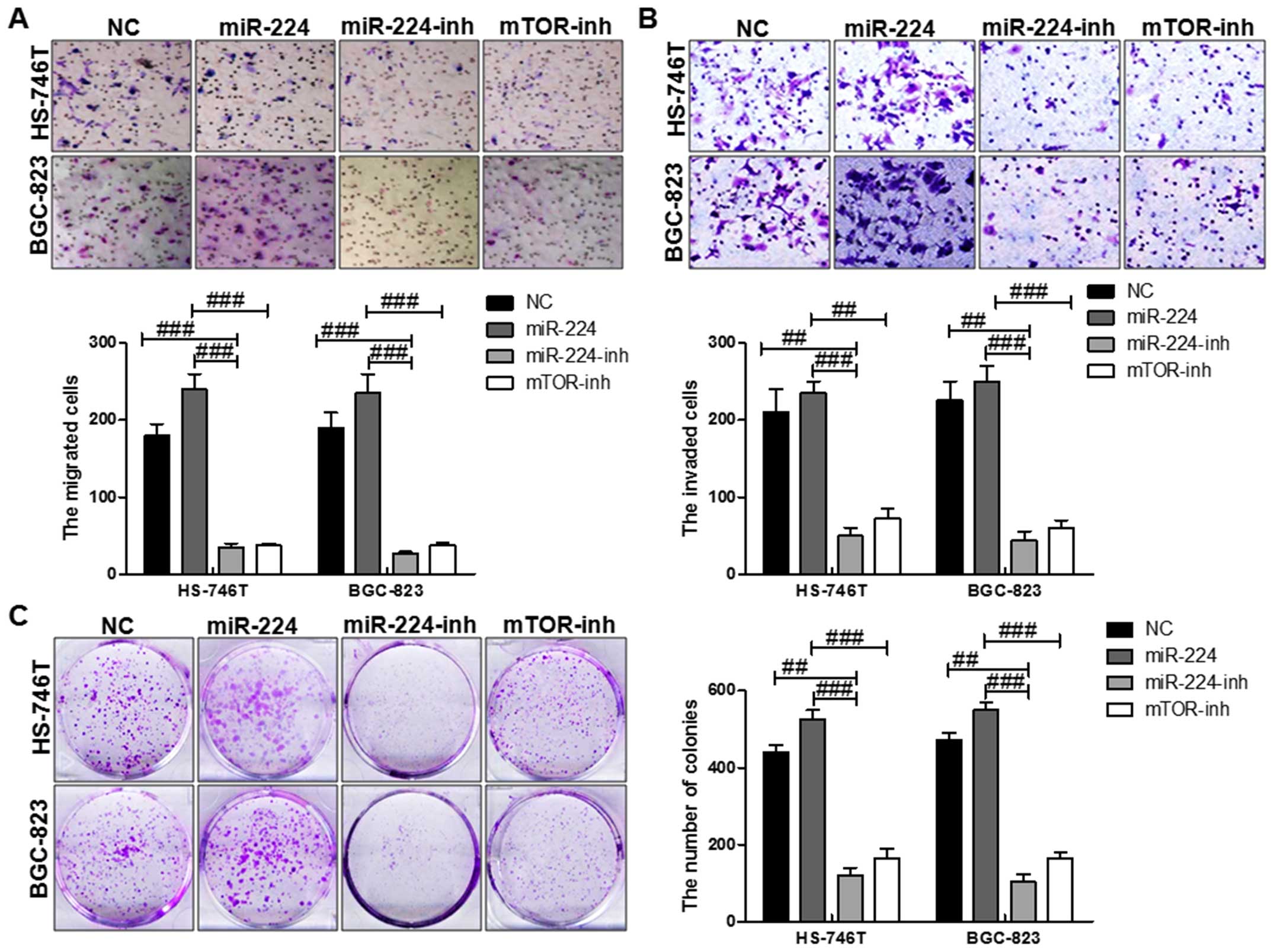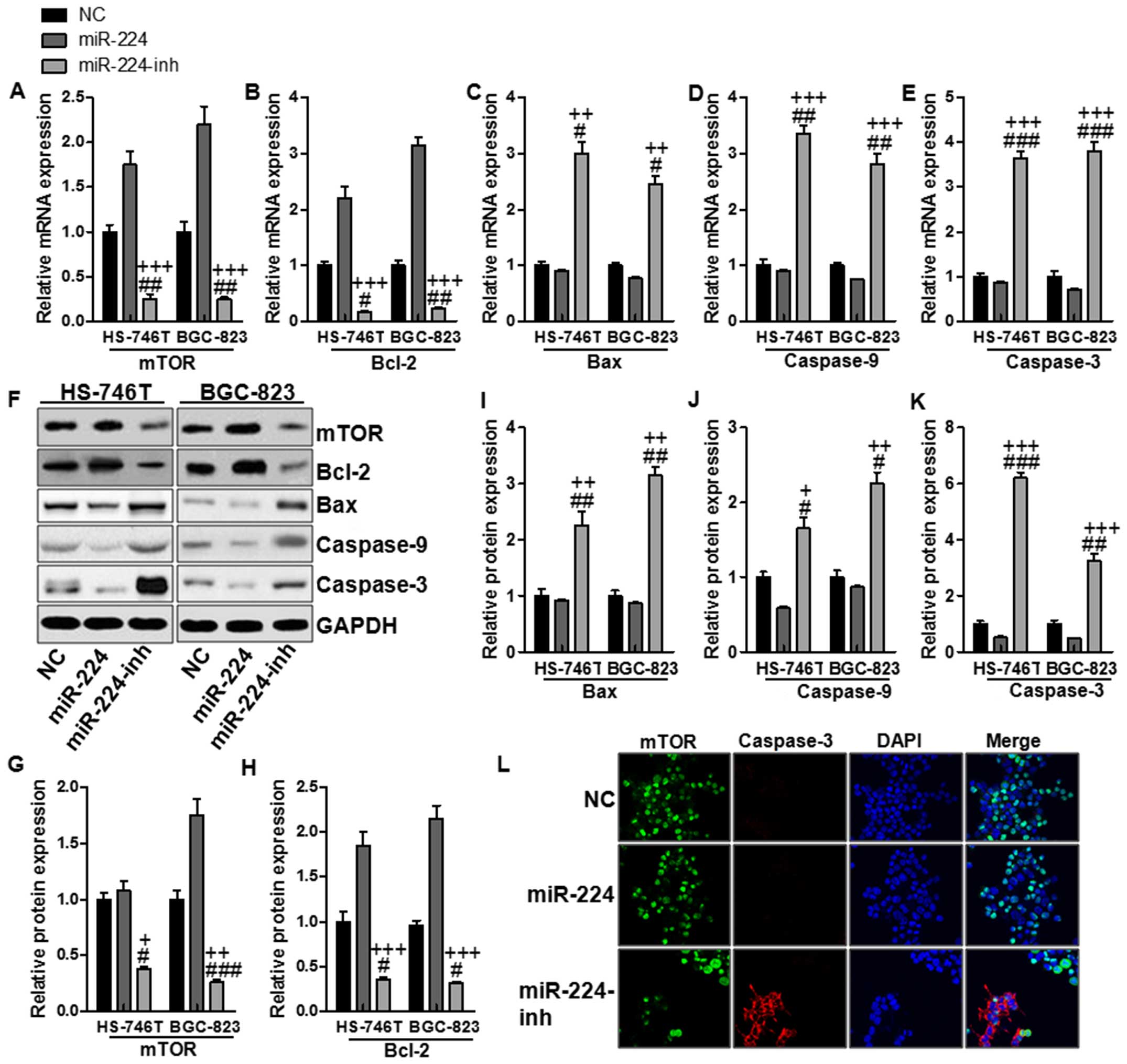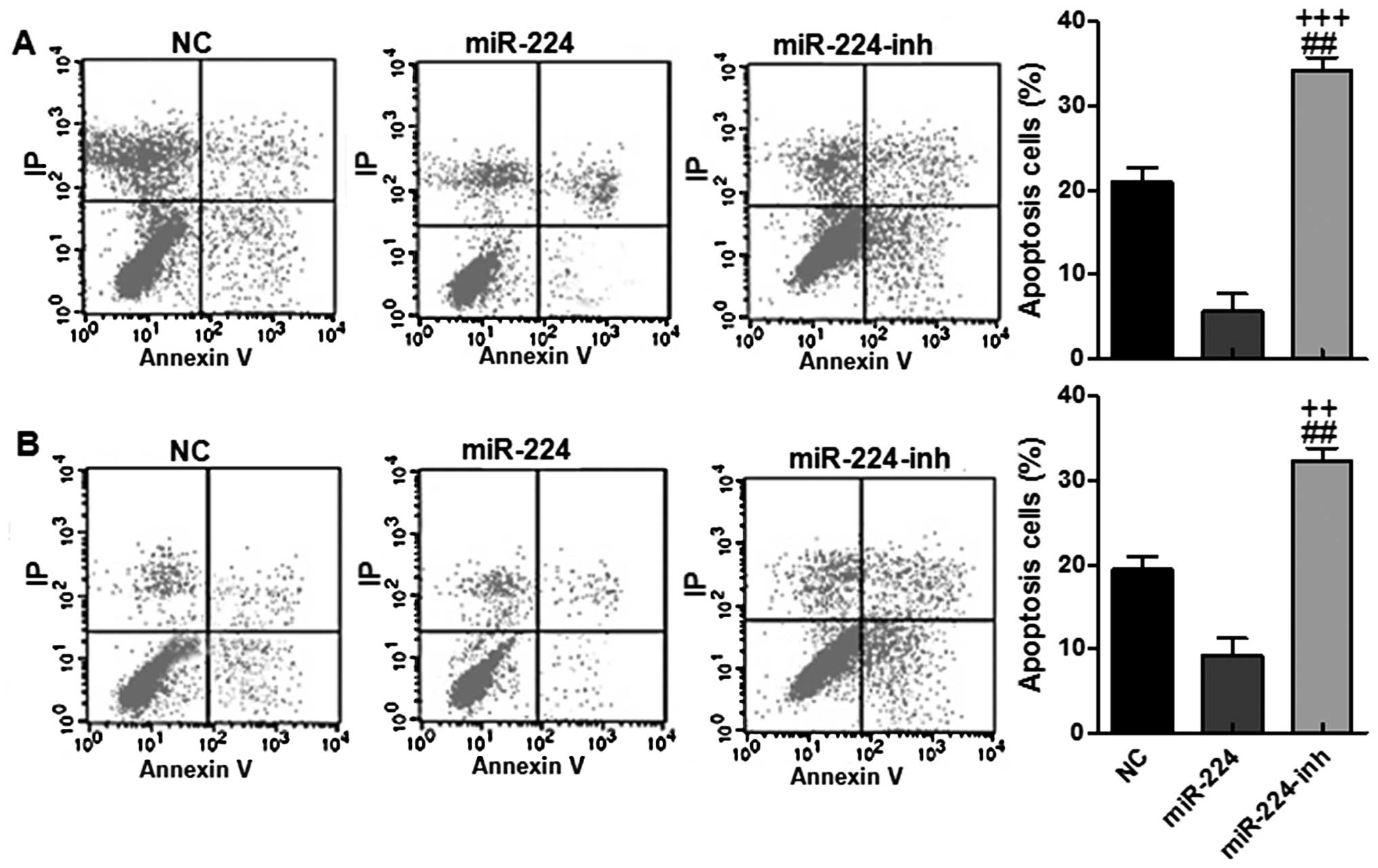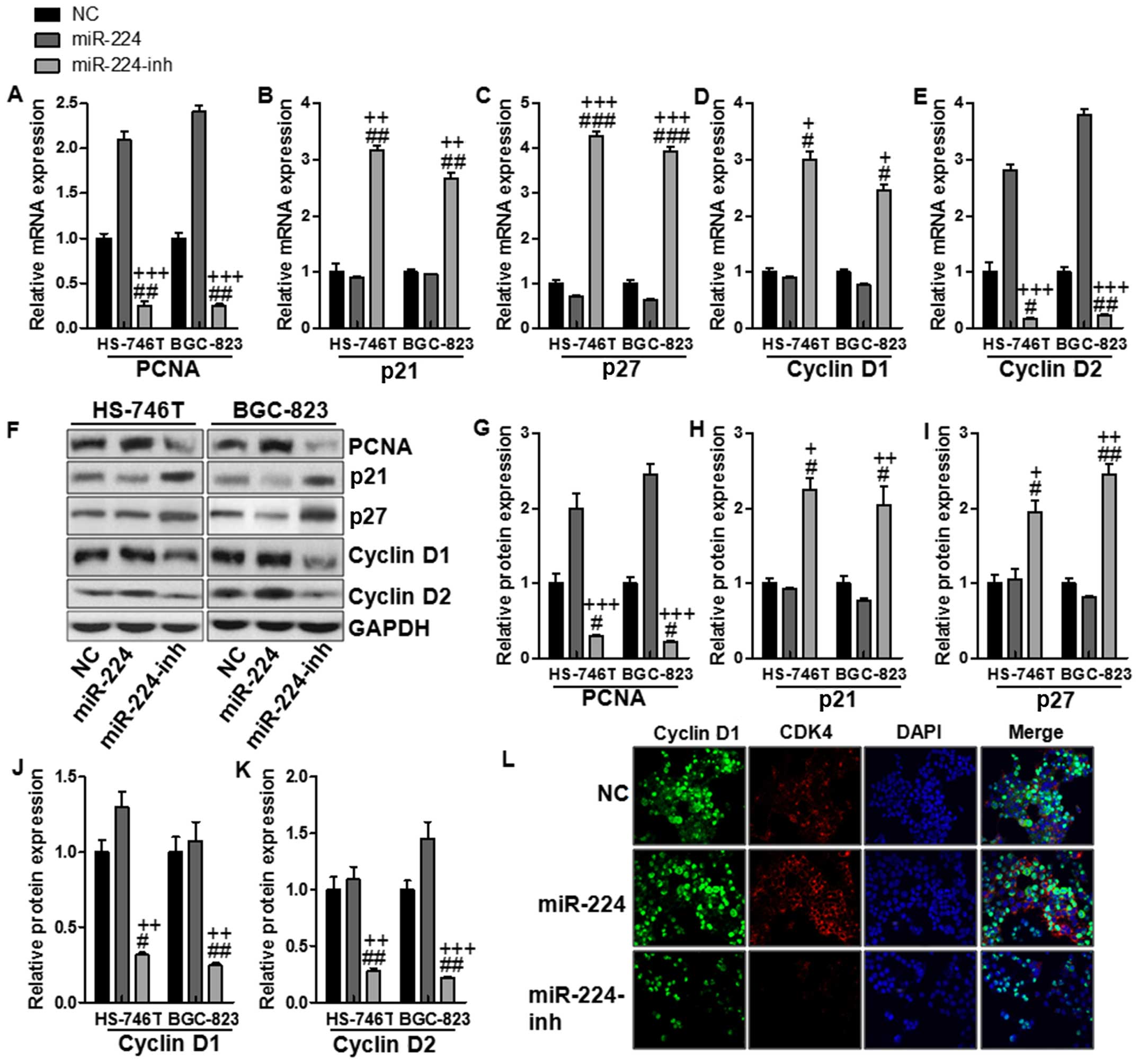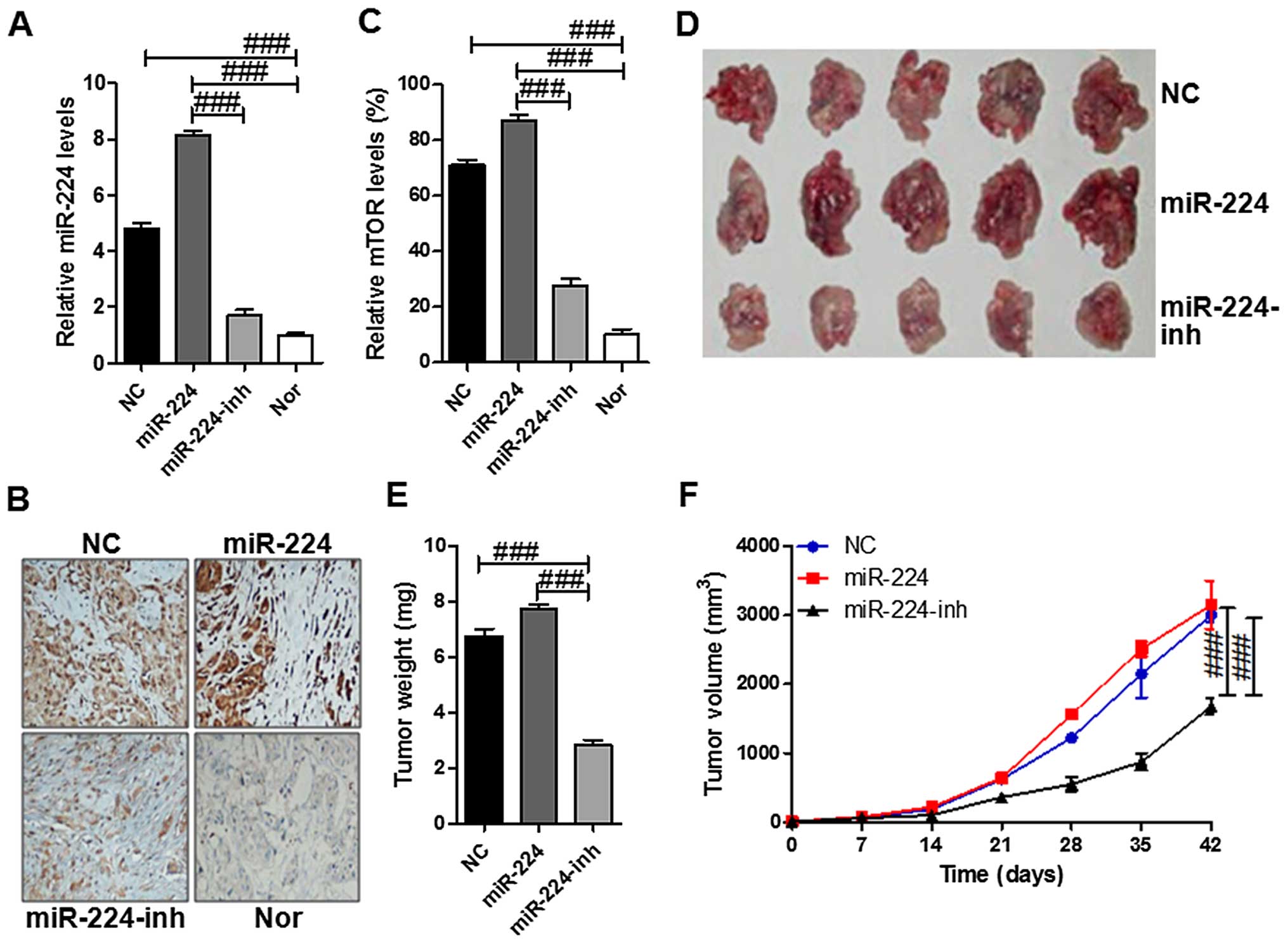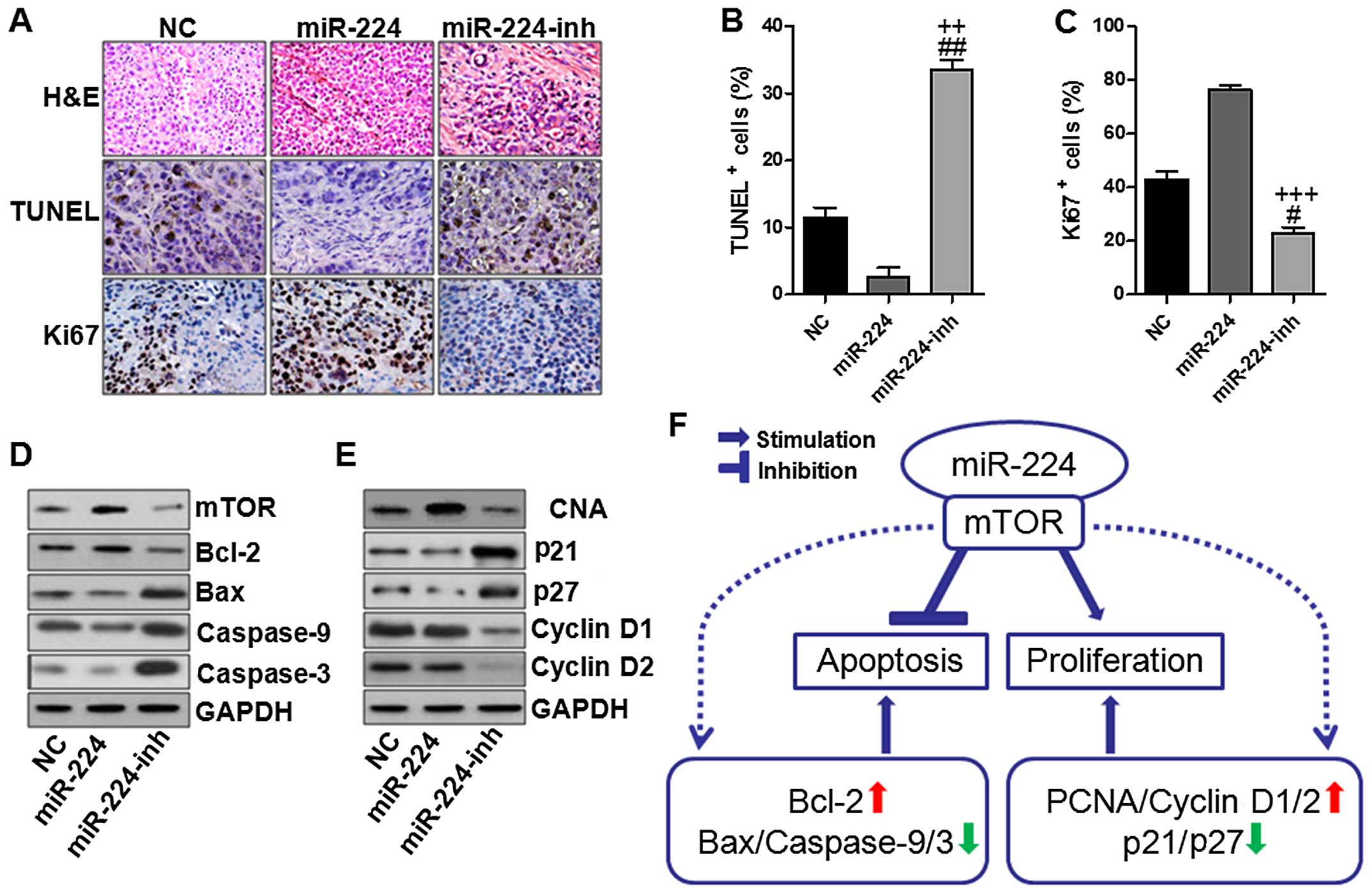MicroRNA-224 aggrevates tumor growth and progression by targeting mTOR in gastric cancer
- Authors:
- Published online on: June 16, 2016 https://doi.org/10.3892/ijo.2016.3581
- Pages: 1068-1080
Abstract
Introduction
Gastric cancer, also known as stomach cancer, is cancer developing from the lining of the stomach (1). Cancer may spread from the stomach to other parts of the body, particularly the liver, lungs, bones, lining of the abdomen and lymph nodes (2). Globally stomach cancer is the fifth leading cause of cancer and the third leading cause of death from cancer making up 7% of cases and 9% of deaths. Gastric cancer is a multifactorial disease (3,4). The pathogenesis of gastric cancer represents a classic example of gene-environment interactions. Cancer of the stomach is difficult to cure unless it is found at an early stage before it has begun to spread. Because early stomach cancer causes few symptoms, the disease is usually advanced when the diagnosis is made (5,6). Thus, currently finding effective target for therapies is necessary to patients.
MiRNAs are one family of small (about 22 nucleotides), non-coding RNAs which play an important role in regulating diverse biological processes, including apoptosis, proliferation, development, differentiation and metabolism (7). Increasing evidence suggest that some miRNAs perform as either tumor suppressors or oncogenes in the tumorigenesis of many types of cancer, and have been reported as potential biomarkers for tumor diagnosis, prognosis and therapy (8,9). Altered miRNA expression in gastric cancer has been found in many different studies. Several deregulated miRNAs in gastric cancer such as miR-185, miR-107, miR-210, miR-99, miR-155 and miR-95 have been shown to regulate cell growth, apoptosis, migration and invasion (10–14). These findings suggest that deregulation of miRNA may be associated with tumorigenesis of gastric cancer. In addition, more extensive investigations are needed to reveal the role of miRNAs in the gastric cancer progression, and those miRNAs may be involved as novel biomarkers for gastric cancer diagnosis, therapy and prognosis. miR-224 is significantly deregulated in many types of cancer, including lung, breast and colon cancer. Since deregulation of miR-224 is common to a number of cancers, it has been supposed that miR-224 may play an essential role in tumor development as well as tumorigenesis (15,16). However, the effects and function of miR-224 remains unclear, especially in gastric cancer.
In the present study, we evaluated miR-224 expression levels in tumor tissues of patients with gastric cancer and we found that miR-224 was significantly upregulated in gastric cancer. We proved that miR-224 could promote gastric cancer cell proliferation and downregulate apoptosis in vitro and in vivo experiments. Furthermore, mTOR, which is usually overexpressed in a variety of human cancers including lung, breast and colon cancer, was identified as a direct target of miR-224. Our results will be helpful for demonstrating the functions of miR-224 and its role in gastric cancer tumorigenesis.
Materials and methods
Tissue specimens and cell cultures
Human gastric cancer and the adjacent normal non-tumor tissues were acquired from patients, undergoing surgical resection in the Department of Gastric Cancer and Soft Tissue Sarcomas, Nanjing Medical Cancer Center of Nanjing Medical University, Nanjing, China, from January 2010 to December 2012 for quantitative RT-PCR analysis. All tissue samples were immediately frozen in the liquid nitrogen and then stored at −80°C for the following studies.
Paraffin-embedded tumor tissues collected from consecutive patients with gastric cancer between January 2010 and December 2012 were performed for tissue assays. Clinical data collection and postoperative follow-up procedures were done based on a uniform guideline of the Nanjing Cancer Center of Nanjing Medical University. Patient characteristics of clinicopathological features are shown in Table I. All samples were collected and analyzed with a prior written informed consent, which was obtained from all patients, and the study was approved by the Clinical Research Ethics Committee of Nanjing Medical University Nanjing Cancer Center.
Cell culture
Human gastric cancer cell lines, including GES-1, HS-746T, MKN-45, HGC-27, SNU-5 and BGC-823, were purchased from the American Type Culture Collection, the Cell Resource Center, Shanghai Institute of Biochemistry and Cell Bank at the Chinese Academy of Sciences. Cell lines were routinely authenticated by DNA-fingerprinting and isoenzyme analyses and checked for contamination by mycoplasma using Hoechst staining. All cell lines were maintained in Roswell Park Memorial Institute (RPMI)-1640, Dulbecco’s modified Eagle’s medium or Minimum Essential Medium, containing 10% fetal bovine serum (FBS) and were incubated at 37°C with 5% CO2.
RNA isolation, reverse transcription (RT) and real-time PCR (RT-PCR)
Total RNA from tissue samples and cultured cells was isolated through the mirVana miRNA Isolation kit (Ambion, Inc., Austin, TX, USA) based on the manufacturer’s instruction. Then the cDNA was synthesized from total RNA with the TaqMan miRNA reverse transcription kit (Applied Biosystems, Foster City, CA, USA). Real-time PCR was conducted using the Applied Biosystems 7500 Sequence Detection system with iQ™ SYBR-Green Supermix (Bio-Rad Laboratories, Hercules, CA, USA) containing 5 ng cDNA and 10 pM of each primer. The data were normalized to the geometric mean of housekeeping gene GAPDH or U6 small nuclear RNA expression and calculated as 2−ΔΔCT method. Sequences of the primers are summarized in Table II.
Plasmids and transfection
In order to produce a miR-224 expression vector, a 281-bp genomic fragment which covers the region coding for pri-miR-224 and its upstream and downstream regions was PCR amplified and then cloned onto the pLVTHM vector (Addgene, Cambridge, MA, USA). The full length of mTOR 3′-UTR is 4739 bp. The miR-224 binding site in mTOR 3′-UTR is located at 4375 to 4381 bp. The region of the human mTOR 3′-UTR from 4553 to 4761 bp was generated by PCR amplification and subcloned into the sites of pGL3-basic luciferase reporter plasmid (Promega, Madison, WI, USA). The miR-224 mimics, negative control and anti-miR-224 inhibitors were purchased from GeneCopoeia (Rockville, MD, USA) and then transfected into gastric cancer cells with Lipofectamine 2000 reagent (Invitrogen, Carlsbad, CA, USA), based on the manufacturer’s instructions. All the primers are listed in Table II.
Luciferase reporter assays
The cells, seeded in a 48-well plate, were co-transfected with 50 nM single-stranded miRNA mimics, anti-miR-224 inhibitors or negative control oligonucleotides, 50 ng of firefly luciferase reporter and 10 ng of pRL-TK (Promega) with the jetPRIME reagent. Cells were collected 36 h after the final transfection, and then analyzed via Dual-luciferase reporter assay system (Promega).
Apoptosis analysis by terminal deoxynucleotidyl transferase-mediated dUTP nick end labeling (TUNEL)
Apoptosis assay of samples was determined by TUNEL using an In Situ Cell Death Detection kit, Fluorescein (Roche Applied Science, Indianapolis, IN, USA) according to the manufacturer’s protocol. The number of TUNEL-positive cells was counted under a fluorescence microscope. The percentages of apoptotic cells were calculated from the ratio of apoptotic cells to total cells counted. Tissue sections were counterstained with hematoxylin. Sections were mounted and observed by light microscopy. The experiment was performed independently three times for each cell line.
Western blot analysis
Proteins were extracted using T-PER Tissue Protein Extraction reagent kit (Thermo Fisher Scientific, Waltham, MA, USA) according to the manufacturer’s instructions. Protein concentrations were determined by BCA protein assay kit, and equal amounts of protein were loaded per well on a 10% sodium dodecyl sulphate poly-acrylamide gel. Subsequently, proteins were transferred onto polyvinylidene difluoride membrane. The resulting membrane was blocked with Tris-buffered saline containing 0.05% Tween-20 (TBS-T), supplemented with 5% skim milk (Sigma-Aldrich, St. Louis, MO, USA) at room temperature for 2 h on a rotary shaker, and followed by TBS-T washing. The specific primary antibody, diluted in TBST, was incubated with the membrane at 4°C overnight. Subsequently, the membrane was washed with TBS-T followed by incubation with the peroxidase-conjugated secondary antibody at room temperature for 1 h. The immunoactive proteins were detected by using an enhanced chemiluminescence western blotting detection kit. Western blot bands were observed using GE Healthcare ECL Western blotting analysis system and exposed to X-ray film (Kodak). The primary antibodies used were: mTOR, Bcl-2, Bax, caspase-9, caspase-3, PCNA, p21, p27, cyclin D1, cyclin D2 and GAPDH.
Colony-forming assay
Gastric cancer cells were suspended in 0.9% methylcellulose-based semisolid medium MethoCult H4100 (StemCell, Beijing, China). After 14 days, individual primary clones (450 cells) were trypsinized and re-plated in the same conditions to examine the secondary colony forming ability for self-renewal.
Migration and invasion assays
For the Transwell migration assays, 10×104 cells were planted in the top chamber with a non-coated membrane. For the invasion assays, 2×105 cells were planted in the top chamber with a Matrigel-coated membrane. For both assays, the cells were seeded in a serum-free medium, and a medium with 10% serum was used as a chemoattractant in the lower chamber. The cells were then incubated for 16 h at 37°C and 5% CO2 in a tissue culture incubator. After 16 h, the non-migrated/non-invading cells were removed from the upper sides of the Transwell membrane filter inserts with cotton-tipped swabs. The migrated/invaded cells on the lower sides of the inserts were then stained with Giemsa, and finally the cells were counted.
Establishment of xenograft tumor models
The mouse experiments were conducted in the Animal Laboratory Center. HS-746T cells (1×107 cells) treated with miR-224 mimics, inhibitors or negative oligonucleotides were suspended in 100 μl serum-free medium and injected subcutaneously into the left flank of 4- to 6-week old male BALB/c nu/nu nude mice. Tumor size was measured with digital caliper and calculated every week. Tumor volume were measured every 7 days and at the end of about 6 weeks after treatment, mice were sacrificed. Tumors were excised, weighed, fixed in 10% neutral formalin, and embedded in paraffin for histological analysis. All animal experiments were performed after obtaining Ethics approval from the Endoscopy Center, China-Japan Union Hospital, Jilin University, Changchun, Jilin, P.R. China.
Immunohistochemistry
The xenograft tumors were performed for hematoxylin and eosin (H&E) staining. In brief, fresh tissues were fixed in paraffin. The sections were then deparaffinized and stained with hematoxylin and eosin solution after being cut into 4 μm slices. Then, the sliced sections were dehydrated and then mounted with Permount. A microscope was used to analyze the results. For the immunohistochemistry, the fresh tumor tissues were fixed in formalin for 48 h. Then the tissue block was put in paraffin and cut into the desired thickness with a microtome, and was then fixed into a slide. After washing, the sections were prepared for blocking and incubating with antibodies, including Ki-67 and mTOR, which was diluted 1:100 in 5% horse serum with PBS at 4°C overnight. Sections were then incubated with diluted streptavidin-peroxidase HRP conjugates at room temperature by a staining kit, based on the manufacturer’s instructions. The sections were then stained with hematoxylin for 3 min and mounted and analyzed under a phase-contrast microscope.
Immunofluorescence assays
After induction by conditioned culture medium, the cells were fixed in 4% paraformaldehyde, permeabilized with 0.1% Triton X-100 in PBS containing 0.5% BSA (PBS-BSA) for 30 min. The cells were subsequently incubated with mTOR, caspase-3, cyclin D1 and CDK4 for 30 min, followed by labeling with Alexa Fluor 488-conjugated rabbit anti-mouse or goat anti-rabbit IgG antibody. The cells were viewed under a fluorescent microscope.
Flow cytometry assays
Flow cytometric assay was used to clarify the cell cycle arrest and cells of apoptosis. The cells were collected with trypsinisation and then washed twice with PBS, and fixed in cold 80% ethanol and finally stored at 4°C overnight. The cells were washed with PBS twice and RNase A (10 mg/ml) was administrated for analysis. Propidium iodide was then added to tubes at a concentration of 0.05 mg/ml and then incubated for 20 min at 4°C in the dark. Cell cycle assays were examined with FACSCalibur flow cytometer. FITC-labeled Annexin V/PI staining was applied based on the manufacturer’s instructions (Nanjing KeyGen Biotech, Co., Ltd., Nanjing, China). In brief, 1×106 cells in each well were suspended with buffer containing FITC-conjugated Annexin V/PI. Samples were then analyzed via flow cytometry.
Statistical analysis
Data are expressed as means ± SEM. Treated cells, tissues and the corresponding controls were compared using GraphPad Prism (version 6.0; GraphPad Software, Inc., La Jolla, CA, USA) by a one-way ANOVA with Dunn’s least significant difference tests. Differences between groups were considered significant at P<0.05.
Results
miR-224 is overexpressed in gastric cancer tissues and cell lines as well as related to the poor survival
We identified several miRNAs abnormally expressed in gastric carcinoma using a GeneChip previously (Table III). Based on the result, we predicted an upstream miRNA: miR-224. In order to investigate the potential role of miR-224 in gastric cancer, the miR-224 levels was evaluated. The results indicated a significantly higher mRNA levels of miR-224 in the gastric cancer samples in comparison to the normal ones with nontumor tissues (Fig. 1A). Also, as shown in Fig. 1B, no varied miR-224 levels were observed in five different gastric cells of HS-746T, MKN-45, HGC-27, SNU-5 and BGC-823, which were expressed markedly higher than that in the normal tissues with non-tumor tissues and in the normal gastric membrane cell line GES-1. Furthermore, we explored the miR-224 expression in tumor tissues from patients (Fig. 1C). Similar to the findings, high levels of miR-224 was associated with the cancer progression that the high overall survival was linked to the lower levels of miR-224. On the contrary, the patients with higher miR-224 displayed shorter survival. RT-PCR results determined that transfection of miR-224 and its inhibitor restored and reduced its expression in HS-746T and BGC-823 cell lines, repectively, compared with the normal gastric cancer cell lines (Fig. 1D and E). As for cell proliferation, restoration of miR-224 in HS-746T and BGC-823 cells resulted in significant enhancement of cell proliferation, the proliferation rate was suppressed in HS-746T and BGC-823 cells after transfection with miR-224 inhibitor (Fig. 1F). In addition, cell cycle assays were performed to determine if the role of miR-224 in cell proliferation was due to the cell cycle arrest. The results indicated that the cells in G1 phase was higher in the HS-746T cells with miR-224 inhibitor compared to the gastric cells treated with or without miR-224 mimics (Fig. 1G). Similar effects of miR-224 were found in BGC-823 cells (Fig. 1H). These results demonstrated that miR-224 regulated the gastric cell proliferation.
Table IIImiRNAs differentially expressed in gastric cancer samples compared with adjacent normal samples. |
miR-244 targets and regulates mTOR expression directly in gastric cancer cells
miRNAs mainly functions via its regulation of target genes, and the target gene of miR-224 was further analyzed. After checking the newly published CLASH data, about 457 genes were targeted by miR-224 in HS-746T cells. Among the genes, mTOR, a key regulator in apoptosis and proliferation, regulating cellular processes, was focused on (17). In order to confirm whether miR-224 could affect the expression of mTOR, we performed luciferase reporter assays in HS-746T cells. We then created luciferase reporter plasmid with wild-type (WT) or mutant (Mut) targeting sequence of mTOR mRNA (Fig. 2A), which were cotransfected with miR-224 mimics or the negative control (NC) oligonucleotides into HS-746T cells for 48 h, and followed by determination of luciferase activity in the transfected cancer cells. Our results indicated that the reporter plasmid with WT targeting sequence of mTOR mRNA caused a significant upregulation of luciferase activity in cells transfected with miR-224, whereas reporter plasmid with mutant sequence of mTOR produced no alteration of luciferase activity (Fig. 2B). Next, we explored if mTOR in gastric cancer cells was regulated similarly. HS-746T and BGC-823 cells were transfected with miR-224 mimics, miR-224 inhibitor or negative control oligonucleotides, and mTOR mRNA and protein levels were examined by RT-PCR and western blot analysis, respectively. mTOR mRNA expressions were higher by miR-224 mimics in HS-746T and BGC-823 cells, respectively (Fig. 2C and D). The level of mTOR protein was consistently and substantially downregulated by miR-224 inhibitor in HS-746T and BGC-823 cells (Fig. 2E and F). Furthermore, we then examined miR-224 expression after the transient transfection of mTOR plasmid into HS-746T and BGC-823 cells. Western blot analysis demonstrated that the transient transfection of mTOR into HS-746T and BGC-823 cells increased mTOR expression at the protein levels. mTOR induced miR-21 expression in the transient transfection experiments in a dose-dependent manner (Fig. 2G and H). Taken together, our results demonstrated that mTOR was a direct target of miR-224 in gastric cancer cells.
miR-224 accelerates gastric cancer cell proliferation and migration partly through mTOR in vitro
mTOR was involved in many cellular processes, including aoptosis, cell growth, diffrentiation and proliferation (18). Thus, we further explored the biological effects of miR-224 on mTOR. Cell function assays showed that upregulation of miR-224 displayed higher proliferation, migration and invasion capacity. At the same time, with miR-224 inhibitor and mTOR inhibition treatment, the migrated cells, invaded cells as well as the colony formation were reversed significantly, which further suggested that miR-224 could promote gastric cancer progression via regulation with mTOR in both HS-746T and BGC-823 cells (Fig. 3). Together, the results showed inhibition of mTOR could partially reverse the influence of miR-224 on cell growth migration, proliferation and invasion.
miR-224 activates the mTOR signaling in HS-746T and BGC-823 cells inhibiting apoptosis in vitro
Previous studies have suggested that miR-224 could accelerate cell proliferation by Wnt/β-catenin signaling (19). In addition, we also observed here that miR-224 could activate mTOR-regulated apoptic signaling pathway via Bcl-2, Bax, caspase-9 and caspase-3 signal expression. As shown in Fig. 4A, RT-PCR was used to further confirm that miR-224 could activate mTOR mRNA levels. Subsequently, it was notable that Bcl2, an important anti-apoptotic factor, was found to be stimulated in miR-224 mimic treatments, while inhibited with miR-224 inhibitor, the Bcl-2 was downregulated significantly (Fig. 4B). Consistently, Bax, a pro-apoptotic factor, was downregulated for miR-224 mimics, while being enhanced for miR-224 inhibitor treatment (Fig. 4C). Next, the downstream signals of caspase-9/3, which are essential regulators for apoptosis, were found to be inhibited in miR-224-overexpressed gastric cell lines (Fig. 4D and E). Similarly, western blot analysis displayed the role of miR-224 in suppressing apoptosis in both HS-746T and BGC-823 cells via mTOR and Bcl-2 upregulation and Bax, caspase-9/3 suppression, respectively (Fig. 4F–H). In this part, finally the immunofluorescence assays were adopted to further confirm the role of miR-224 in apoptosis inhibition in HS-746T gastric cells, which showed higher mTOR expressive intensity while with lower caspase-3 immunofluorescent intensity in the miR-224 groups (Fig. 4L). In addition, flow cytometry was conducted to reveal that the apoptotic cells were lower in groups with miR-224 high expression in both HS-746T and BGC-823 cell lines, while after being treated with miR-224 inhibitor, the apoptotic gastric cells were upregulated (Fig. 5A and B). Collectively, our results above suggested that miR-224 could promote gastric cancer progression via apoptosis suppression.
The effects of miR-224 on proliferation in the gastric cancer cell lines
In this regard, cell proliferation was determined to clarify whether miR-224-regulated mTOR signaling pathway was involved in gastric cancer progression. RT-PCR was conducted to determine PCNA, p21, p27, cyclin D1 and cyclin D2 levels. As shown in Fig. 6A, PCNA was upregulated for miR-224 mimics, while being reduced in miR-224 inhibitor treatment. Also, p21 and p27, as important factors inhibiting cell proliferation, decrease cyclin D1 and cyclin D2 expression. Fig. 6B–E shows downregulated p21 and p27 were observed in the miR-224 groups, which were reversed for miR-224 inhibitor treatment in both gastric cancer cells. Consistently, cyclin D1 and cyclin D2 were suppressed in the miR-224-inh groups, suggesting that miR-224 inhibition might be a potential therapeutic strategy for gastric cancer via cell proliferation inhibition. In addition, western blot assays were conducted to confirm that cyclin D1 and cyclin D2 were indeed involved in miR-224-regulated mTOR signaling pathway. The results were similar to mRNA levels. Fig. 6F–K shows PCNA, cyclin D1, and cyclin D2 protein levels were upregulated in the miR-224 groups, while being downregulated in miR-224-inh groups. Conversely, p21 and p27 were decreased for miR-224 mimics and were increased due to miR-224 inhibitor usage. Finally, immunofluorescence was used to confirm that cyclin D1 and CDK4, as important cooperator of cyclin D1, were both stimulated with high fluorescent intensity in miR-224 mimic groups, which were weakened for miR-224 inhibitor treatment in the HS-746T gastric cancer cells (Fig. 6L). Our results above suggested that miR-224 could promote cell proliferation, leading to gastric cancer progression.
miR-224 promotes tumor growth by targeting mTOR in vivo
To understand whether mTOR is involved in miR-224 mediated tumorigenesis in vivo, we engineered HS-746T cells to stably overexpress miR-224. The control cells, miR-224-overexpressing cells and the restored mTOR in miR-224-overexpressing cells were subcutaneously inoculated into nude mice, respectively. As shown in Fig. 7A, the miR-224 levels were higher in the tissue samples with miR-224 mimics of HS-746T cells injection compared to the one with miR-224-inhibitor. In addition, the mTOR expressed levels displaying similar change with miR-224 via immunohistochemical assays that mTOR was expressed highly in the miR-224 group while being suppressed in the miR-224-inh groups (Fig. 7B and C). Next, the tumor incidence was evaluated biweekly, and tumors appeared in all the mice. As shown in the Fig. 7D–F, the tumors in the miR-224 group grew much more rapidly than the other two tumor groups. Furthermore, the forced expression of miR-224 significantly inhibited tumor growth in vivo. These results indicated that miR-224 stimulated tumor growth and mTOR was involved in the progression of tumor growth in vivo.
miR-224 inhibits apoptosis and enhanced proliferation in gastric cancer in vivo
In this regard, we further determined the role of miR-224 in the gastric cancer development in vivo. As shown in Fig. 8A–C, immunohischemical analysis was used to confirm that the tumors of the miR-224-overexpressed group displayed lower TUNEL positive cells while much higher Ki-67 indexes than the other two groups. In order to further verify the above data and observations as well as the possible molecular mechanisms, we assessed the mTOR-regulated apoptotic signaling pathway and cyclin D1/2-associated cell proliferation. Consistenly, in vivo experiments we found that mTOR overexpressed in the miR-224 groups in comparison to the other two groups (Fig. 8D). And also, Bcl-2 was expressed highly, which was inhibited in miR-224 inhibitor use. Subsequently, caspase-9/3 were inactivated due to miR-224 overexpression, which were activated for miR-224 inhibitor, leading to apoptosis in the gastric cancer cells. Furthermore, miR-224 could aggravate gastric cancer development via cell proliferation upregulation of PCNA, cyclin D1/2, while downregulated p21 and p27 (Fig. 8E). However, expression of these proteins could be reversed for miR-224 inhibition, suggesting that suppressing miR-224 could reduce gastric cancer progression. The above molecular link provided a significant clue to the role of miR-224 in the process of gastric cancer via mTOR-regulated signaling pathway.
Discussion
Presently, gastric cancer remains a major threat to human health. Despite improvements in surgery and chemotherapy, the outcomes in patients with advanced gastric cancer remain poor, with a 5-year survival rate of less than 20% (20,21). Over the past several years, targeted therapies have indeed improved the outcome of a number of malignancies greatly, including colorectal, lung and breast cancer (22,23). However, less progress has been made regarding gastric cancer. Molecular mechanism research on the different phases of this disease will be useful and valuable for a better diagnosis and development of therapeutic strategy.
MicroRNAs are small non-coding RNAs that regulate the expression of target genes by inhibiting translation and/or stability of mRNAs (24). Accumulated evidence demonstrates that miRNAs play an important role in many different biological processes, such as differentiation, proliferation, survival, apoptosis, metabolism and development (25,26). Numerous miRNAs act as either tumor suppressors or oncogenes, and the aberrant miRNAs expression is included in the initiation and progression of human tumors or cancers (27). miR-224 has been indicated to be increased in several solid tumors, including colorectal cancer, hepatocellular carcinoma, lung and breast cancer, and repressing many targets, such as SMAD4, API5, PHLPP1 and PHLPP2, promoting the migratory, invasive and proliferative capacity of cancer cells (28,29). However, further studies need to be done to clarify the biological function of miR-224 in gastric cancer progression due to its potential role in development of many other tumors.
In order to better understand the underlying oncogenic role of miR-224 in gastric cancer, we attempted to find other potential targets of miR-224. In the present study, we report that mTOR is a novel direct target of miR-224 that could be implicated in miR-224-induced gastric cancer cell proliferation and invasion.
Mammalian target of rapamycin (mTOR) is a component of the phosphatidylinositol 3-kinase (PI3K) cell survival pathway that monitors the availability of nutrients, mitogenic signals, cellular energy as well as oxygen levels, and thus is vital in the regulation of cell growth and proliferation (30–32). Abnormal activation of PI3K pathway is thought to be associated with numerous cancers, and according to previous studies increased activation of this pathway is often related to resistance to cancer therapies (33). mTOR, as an essential signal belonging to PI3K/AKT signaling pathway, operates a key junction in the PI3K pathway-regulated cellular process (34). Overall, the role of mTOR in gastric cancer remains unclear. In the present study, we found that the expression of mTOR is upregulated significantly in gastric cancer cells or tissues compared to the normal ones, and higher mTOR expression potentially contributes to the poor overall survival of gastric cancer patients. We further demonstrated a significant proportional correlation between miR-224 and mTOR in gastric cancer cell samples. Moreover, inhibition of mTOR induced same phenotypes as the suppression of miR-224 in gastric cancer cells. These results suggest that mTOR and miR-224 have collaborative interactions mediating gastric cancer progression. To the best of our knowledge, there is no report regarding the role of mTOR in cell proliferation in gastric cacner progression via miR-224 regulation. The present study demonstrated that mTOR positively regulates gastric cancer cell proliferation, invasion and migration. However, further studies need to be done to reveal the underlying mechanism of mTOR in the proliferation, invasion and migration of gastric cancer.
In light of the significant upregulation of miR-224 in gastric cancer and the fact that mTOR is a direct target of miR-224, upregulated mTOR might be attributable to the increased miR-224 expression in gastric cancer. We found that mTOR expression was significantly upregulated in gastric cancer. Next, we intended to clarify the possible mechanism by which miR-224 and mTOR regulated gastric cancer progression. We found that miR-224 significantly stimulated Bcl-2 expression via mTOR upregulation in vivo and in vitro experiments, inducing Bax, caspase-9 and caspase-3 down-regulation, inhibiting apoptosis in gastric cancer development. Caspase-3 is known as an essential activator for apoptosis development in tissues and cells via Bcl-2 and its family members, which are involved in cancer progression based on previous studies (35–37). Notably, miR-224 suppression could reverse expression of these proteins with mTOR and Bcl-2 downregulation while with Bax, caspase-9 and caspase-3 were upregulated, thus, leading to apoptosis in gastric cancer and promoting cancer cell attenuating gastric cancer progression. Collectively, the results above elucidated that miR-224 might be linked to gastric cancer progression via mTOR-regulated caspase-3 signaling pathway. In addition, inhibiting miR-224, causing high expression of caspase-3, could be effective in treating gastric cancer through apoptosis activation.
mTOR exists as two separate complexes in the cytoplasm (TORC1 and TORC2), which could regulate progression of the cell cycle from the G1 to S phase through cyclin D. PNCA, p21, and p27, cyclin D1 and cyclin D2 are known to be closely associated with the cell cycle, leading to the alteration of cell proliferation (38,39). G1/S progression is mainly regulated by cyclin D1 and the cyclin-dependent kinase 4 (CDK4) (40). PCNA is an acidic nuclear protein, being recognized as a histological marker for the G1/S phase in the cell cycle (41). p21 is a CDK inhibitor, which can bind to CDK-cyclin complexes and alter their function in order to suppress cell proliferation (39). In the present study, we found that PCNA and cyclin D1/2 were stimulated due to miR-224 upregulation in vivo and in vitro experiments, promoting gastric cancer cell proliferation, which was consistent with previous studies. However, after miR-224 suppression, we found that overexpressed PCNA, cyclin D1/2 were downregulated, while p21, and p27 were upregulated, which might perform their role in suppressing cell proliferation. Also, the immunofluorescent assays further confirmed that higher levels of cyclin D1 with increased CDK4 expression in miR-224 groups indicated enhanced gastric cancer cell proliferation due to miR-224. In addition, the weak fluorescent intensity of cyclin D1 and CDK4 suggested that the cell proliferation of gastric cancer was inhibited in miR-224 suppression. Our data above suggested that miR-224 could be a target for gastric cancer suppression via mTOR-regulated apoptosis and cell proliferation by caspase and cyclin D modulation.
The present study is the first to document the tumor promoter role of miR-224 in gastric cancer progression. miR-224 could suppress apoptosis and enhance migratory, invasive and proliferative behaviors by improving the expression of mTOR, reducing apoptosis and enhancing cell proliferation (Fig. 8F). Our results illustrated that the inhibition of the tumor promoter miR-224 might be useful and efective in the treatment of gastric cancer.
References
|
JeJemal A, Bray F, Center MM, Ferlay J, Ward E and Forman D: Global cancer statistics. CA Cancer J Clin. 61:69–90. 2011. View Article : Google Scholar | |
|
Verdecchia A, Santaquilani M and Sant M: Survival for cancer patients in Europe. Ann Ist Super Sanita. 45:315–324. 2009.PubMed/NCBI | |
|
Deng N, Goh LK, Wang H, Das K, Tao J, Tan IB, Zhang S, Lee M, Wu J, Lim KH, et al: A comprehensive survey of genomic alterations in gastric cancer reveals systematic patterns of molecular exclusivity and co-occurrence among distinct therapeutic targets. Gut. 61:673–684. 2012. View Article : Google Scholar : PubMed/NCBI | |
|
Bang YJ, Van Cutsem E, Feyereislova A, Chung HC, Shen L, Sawaki A, Lordick F, Ohtsu A, Omuro Y, Satoh T, et al; ToGA Trial Investigators. Trastuzumab in combination with chemotherapy versus chemotherapy alone for treatment of HER2-positive advanced gastric or gastro-oesophageal junction cancer (ToGA): A phase 3, open-label, randomised controlled trial. Lancet. 376:687–697. 2010. View Article : Google Scholar : PubMed/NCBI | |
|
Lee J, Seo JW, Jun HJ, Ki CS, Park SH, Park YS, Lim HY, Choi MG, Bae JM, Sohn TS, et al: Impact of MET amplification on gastric cancer: Possible roles as a novel prognostic marker and a potential therapeutic target. Oncol Rep. 25:1517–1524. 2011.PubMed/NCBI | |
|
Sasaki T, Kuniyasu H, Luo Y, Kitayoshi M, Tanabe E, Kato D, Shinya S, Fujii K, Ohmori H and Yamashita Y: AKT activation and telomerase reverse transcriptase expression are concurrently associated with prognosis of gastric cancer. Pathobiology. 81:36–41. 2014. View Article : Google Scholar | |
|
Jiang YW and Chen LA: microRNAs as tumor inhibitors, oncogenes, biomarkers for drug efficacy and outcome predictors in lung cancer (Review). Mol Med Rep. 5:890–894. 2012.PubMed/NCBI | |
|
Zhou C, Li G, Zhou J, Han N, Liu Z and Yin J: miR-107 activates ATR/Chk1 pathway and suppress cervical cancer invasion by targeting MCL1. PLoS One. 9:e1118602014. View Article : Google Scholar : PubMed/NCBI | |
|
Roldo C, Missiaglia E, Hagan JP, Falconi M, Capelli P, Bersani S, Calin GA, Volinia S, Liu CG, Scarpa A, et al: MicroRNA expression abnormalities in pancreatic endocrine and acinar tumors are associated with distinctive pathologic features and clinical behavior. J Clin Oncol. 24:4677–4684. 2006. View Article : Google Scholar : PubMed/NCBI | |
|
Takahashi Y, Forrest AR, Maeno E, Hashimoto T, Daub CO and Yasuda J: MiR-107 and MiR-185 can induce cell cycle arrest in human non-small cell lung cancer cell lines. PLoS One. 4:e66772009. View Article : Google Scholar | |
|
Zeng L, He X, Wang Y, Tang Y, Zheng C, Cai H, Liu J, Wang Y, Fu Y and Yang GY: MicroRNA-210 overexpression induces angiogenesis and neurogenesis in the normal adult mouse brain. Gene Ther. 21:37–43. 2014. View Article : Google Scholar | |
|
Wang L, Chang L, Li Z, Gao Q, Cai D, Tian Y, Zeng L and Li M: miR-99a and -99b inhibit cervical cancer cell proliferation and invasion by targeting mTOR signaling pathway. Med Oncol. 31:9342014. View Article : Google Scholar : PubMed/NCBI | |
|
Marcucci G, Maharry KS, Metzeler KH, Volinia S, Wu YZ, Mrózek K, Nicolet D, Kohlschmidt J, Whitman SP, Mendler JH, et al: Clinical role of microRNAs in cytogenetically normal acute myeloid leukemia: miR-155 upregulation independently identifies high-risk patients. J Clin Oncol. 31:2086–2093. 2013. View Article : Google Scholar : PubMed/NCBI | |
|
Huang X, Taeb S, Jahangiri S, Emmenegger U, Tran E, Bruce J, Mesci A, Korpela E, Vesprini D, Wong CS, et al: miRNA-95 mediates radioresistance in tumors by targeting the sphingolipid phosphatase SGPP1. Cancer Res. 73:6972–6986. 2013. View Article : Google Scholar : PubMed/NCBI | |
|
Mees ST, Mardin WA, Sielker S, Willscher E, Senninger N, Schleicher C, Colombo-Benkmann M and Haier J: Involvement of CD40 targeting miR-224 and miR-486 on the progression of pancreatic ductal adenocarcinomas. Ann Surg Oncol. 16:2339–2350. 2009. View Article : Google Scholar : PubMed/NCBI | |
|
Huang L, Dai T, Lin X, Zhao X, Chen X, Wang C, Li X, Shen H and Wang X: MicroRNA-224 targets RKIP to control cell invasion and expression of metastasis genes in human breast cancer cells. Biochem Biophys Res Commun. 425:127–133. 2012. View Article : Google Scholar : PubMed/NCBI | |
|
Lee DF and Hung MC: All roads lead to mTOR: Integrating inflammation and tumor angiogenesis. Cell Cycle. 6:3011–3014. 2007. View Article : Google Scholar : PubMed/NCBI | |
|
Gridelli C, Maione P and Rossi A: The potential role of mTOR inhibitors in non-small cell lung cancer. Oncologist. 13:139–147. 2008. View Article : Google Scholar : PubMed/NCBI | |
|
Li T, Lai Q, Wang S, Cai J, Xiao Z, Deng D, He L, Jiao H, Ye Y, Liang L, et al: MicroRNA-224 sustains Wnt/β-catenin signaling and promotes aggressive phenotype of colorectal cancer. J Exp Clin Cancer Res. 35:21–27. 2016. View Article : Google Scholar | |
|
Sasaki T, Kuniyasu H, Luo Y, Kitayoshi M, Tanabe E, Kato D, Shinya S, Fujii K, Ohmori H and Yamashita Y: Increased phosphorylation of AKT in high-risk gastric mucosa. Anticancer Res. 33:3295–3300. 2013.PubMed/NCBI | |
|
Sukawa Y, Yamamoto H, Nosho K, Kunimoto H, Suzuki H, Adachi Y, Nakazawa M, Nobuoka T, Kawayama M, Mikami M, et al: Alterations in the human epidermal growth factor receptor 2-phosphatidylinositol 3-kinase-v-Akt pathway in gastric cancer. World J Gastroenterol. 18:6577–6586. 2012. View Article : Google Scholar : PubMed/NCBI | |
|
Poplawski T, Tomaszewska K, Galicki M, Morawiec Z and Blasiak J: Promoter methylation of cancer-related genes in gastric carcinoma. Exp Oncol. 30:112–116. 2008.PubMed/NCBI | |
|
Oue N, Motoshita J, Yokozaki H, Hayashi K, Tahara E, Taniyama K, Matsusaki K and Yasui W: Distinct promoter hyper-methylation of p16INK4a, CDH1, and RAR-beta in intestinal, diffuse-adherent, and diffuse-scattered type gastric carcinomas. J Pathol. 198:55–59. 2002. View Article : Google Scholar : PubMed/NCBI | |
|
Shi XB, Xue L, Ma AH, Tepper CG, Kung HJ and White RW: miR-125b promotes growth of prostate cancer xenograft tumor through targeting pro-apoptotic genes. Prostate. 71:538–549. 2011. View Article : Google Scholar : | |
|
Szabó DR, Luconi M, Szabó PM, Tóth M, Szücs N, Horányi J, Nagy Z, Mannelli M, Patócs A, Rácz K, et al: Analysis of circulating microRNAs in adrenocortical tumors. Lab Invest. 94:331–339. 2014. View Article : Google Scholar | |
|
Filipowicz W, Bhattacharyya SN and Sonenberg N: Mechanisms of post-transcriptional regulation by microRNAs: Are the answers in sight? Nat Rev Genet. 9:102–114. 2008. View Article : Google Scholar : PubMed/NCBI | |
|
Guo H, Liu H, Mitchelson K, Rao H, Luo M, Xie L, Sun Y, Zhang L, Lu Y, Liu R, et al: MicroRNAs-372/373 promote the expression of hepatitis B virus through the targeting of nuclear factor I/B. Hepatology. 54:808–819. 2011. View Article : Google Scholar : PubMed/NCBI | |
|
Prueitt RL, Yi M, Hudson RS, Wallace TA, Howe TM, Yfantis HG, Lee DH, Stephens RM, Liu CG, Calin GA, et al: Expression of microRNAs and protein-coding genes associated with perineural invasion in prostate cancer. Prostate. 68:1152–1164. 2008. View Article : Google Scholar : PubMed/NCBI | |
|
Li Q, Wang G, Shan J-L, Yang ZX, Wang HZ, Feng J, Zhen JJ, Chen C, Zhang ZM, Xu W, et al: MicroRNA-224 is upregulated in HepG2 cells and involved in cellular migration and invasion. J Gastroenterol Hepatol. 25:164–171. 2010. View Article : Google Scholar | |
|
Bhaskar PT and Hay N: The two TORCs and Akt. Dev Cell. 12:487–502. 2007. View Article : Google Scholar : PubMed/NCBI | |
|
Tokunaga C, Yoshino K and Yonezawa K: mTOR integrates amino acid- and energy-sensing pathways. Biochem Biophys Res Commun. 313:443–446. 2004. View Article : Google Scholar | |
|
Betz C and Hall MN: Where is mTOR and what is it doing there? J Cell Biol. 203:563–574. 2013. View Article : Google Scholar : | |
|
Frias MA, Thoreen CC, Jaffe JD, Schroder W, Sculley T, Carr SA and Sabatini DM: mSin1 is necessary for Akt/PKB phosphorylation, and its isoforms define three distinct mTORC2s. Curr Biol. 16:1865–1870. 2006. View Article : Google Scholar : PubMed/NCBI | |
|
Betz C, Stracka D, Prescianotto-Baschong C, Frieden M, Demaurex N and Hall MN: Feature Article: mTOR complex 2-Akt signaling at mitochondria-associated endoplasmic reticulum membranes (MAM) regulates mitochondrial physiology. Proc Natl Acad Sci USA. 110:12526–12534. 2013. View Article : Google Scholar : PubMed/NCBI | |
|
Chang HY and Yang X: Proteases for cell suicide: Functions and regulation of caspases. Microbiol Mol Biol Rev. 64:821–846. 2000. View Article : Google Scholar : PubMed/NCBI | |
|
Beurel E and Jope RS: The paradoxical pro- and anti-apoptotic actions of GSK3 in the intrinsic and extrinsic apoptosis signaling pathways. Prog Neurobiol. 79:173–189. 2006. View Article : Google Scholar : PubMed/NCBI | |
|
Yo YT, Shieh GS, Hsu KF, Wu CL and Shiau AL: Licorice and licochalcone-A induce autophagy in LNCaP prostate cancer cells by suppression of Bcl-2 expression and the mTOR pathway. J Agric Food Chem. 57:8266–8273. 2009. View Article : Google Scholar : PubMed/NCBI | |
|
Lapenna S and Giordano A: Cell cycle kinases as therapeutic targets for cancer. Nat Rev Drug Discov. 8:547–566. 2009. View Article : Google Scholar : PubMed/NCBI | |
|
Chen Y, Robles AI, Martinez LA, Liu F, Gimenez-Conti IB and Conti CJ: Expression of G1 cyclins, cyclin-dependent kinases, and cyclin-dependent kinase inhibitors in androgen-induced prostate proliferation in castrated rats. Cell Growth Differ. 7:1571–1578. 1996.PubMed/NCBI | |
|
Kastan MB and Bartek J: Cell-cycle checkpoints and cancer. Nature. 432:316–323. 2004. View Article : Google Scholar : PubMed/NCBI | |
|
Zhong W, Peng J, He H, Wu D, Han Z, Bi X and Dai Q: Ki-67 and PCNA expression in prostate cancer and benign prostatic hyperplasia. Clin Invest Med. 31:E8–E15. 2008.PubMed/NCBI |



